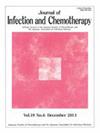核心基因组多焦点序列分型与基于聚合酶链式反应的开放读码框分型在追踪非社会性耐甲氧西林金黄色葡萄球菌传播方面的效果比较。
IF 1.9
4区 医学
Q3 INFECTIOUS DISEASES
引用次数: 0
摘要
导言:在日本,耐甲氧西林金黄色葡萄球菌(MRSA)迅速从金黄色葡萄球菌盒式染色体mec(SCCmec)II型/ST5型向SCCmec IV型/克隆复合体(CC)1 MRSA发生克隆转移。我们之前在一家老年病医院进行的研究发现,SCCmec IV 型/CC1 MRSA 在长期护理病房中很普遍。由于需要密集的个人护理,与医护人员的频繁接触有可能造成 MRSA 的意外传播。我们进行了基于聚合酶链式反应的开放阅读框分型(POT)和核心基因组多焦点序列分型(cgMLST),以调查院内传播的发生情况,并比较这两种方法的结果:方法:对 83 例 MRSA 分离物进行 POT 和全基因组测序。使用商用自动软件(Ridom SeqSphere+)进行 cgMLST 测序。等位基因差异在 0 到 8 之间的 MRSA 分离物被认为是相关的,这些病例都查阅了病历:结果:SCCmec IV/CC1 型 MRSA 是最常检测到的克隆(n=56,67.5%),分为 14 种 POT 类型,其次是 SCCmec I/ST8 型(n=9)和 SCCmec IV/ST8 型(n=8)。在 11 个病房中,有 7 个病房发现了相同的 POT 类型。然而,cgMLST 分析仅发现三例(六株)基因高度相似,表明存在院内传播;其中只有一例涉及 SCCmec IV/CC1 型(两株)。同一病房中 POT 类型相同的菌株之间核心基因组的等位基因平均差异为 55.3 ± 22.0:事实证明,与 POT 相比,cgMLST 方法能更有效地识别院内传播,突出了它在追踪 MRSA 在医疗机构中传播情况方面的实用性。本文章由计算机程序翻译,如有差异,请以英文原文为准。
Comparison of the effectiveness of core genome multilocus sequence typing and polymerase chain reaction-based open reading frame typing in tracing nosocomial methicillin-resistant Staphylococcus aureus transmission
Introduction
A clonal shift from staphylococcal cassette chromosome mec (SCCmec) type II/ST5 methicillin-resistant Staphylococcus aureus (MRSA) to SCCmec type IV/clonal complex (CC)1 MRSA has occurred rapidly in Japan. Our previous research in a geriatric hospital found SCCmec type IV/CC1 MRSA prevalence in long-term care wards. Due to intensive personal care requirements, frequent contact with healthcare providers can potentially cause unintentional nosocomial MRSA transmission. We performed polymerase chain reaction-based open reading frame typing (POT) and core genome multilocus sequence typing (cgMLST) to investigate the occurrence of nosocomial transmission and to compare the results of these methods.
Methods
POT and whole genome sequencing were performed in 83 MRSA isolates. Commercial automated software (Ridom SeqSphere+) was used to perform cgMLST. MRSA isolates with 0–8 allelic differences were considered related, and medical records were consulted in these cases.
Results
SCCmec type IV/CC1 MRSA was the most frequently detected clone (n = 56, 67.5 %), which was divided into 14 POT types, followed by SCCmec type I/ST8 (n = 9) and SCCmec type IV/ST8 (n = 8). Identical POT types were found across 7 of 11 wards. However, cgMLST analysis identified only three cases (six strains) of high genetic similarity, indicating nosocomial transmission; only one involved SCCmec type IV/CC1 (two strains). The mean allelic difference in the core genomes between strains with identical POT types in the same ward was 55.3 ± 22.0.
Conclusions
The cgMLST method proved more effective for identifying nosocomial transmissions compared to POT, highlighting its utility in tracking MRSA spread in healthcare settings.
求助全文
通过发布文献求助,成功后即可免费获取论文全文。
去求助
来源期刊

Journal of Infection and Chemotherapy
INFECTIOUS DISEASES-PHARMACOLOGY & PHARMACY
CiteScore
4.10
自引率
4.50%
发文量
303
审稿时长
47 days
期刊介绍:
The Journal of Infection and Chemotherapy (JIC) — official journal of the Japanese Society of Chemotherapy and The Japanese Association for Infectious Diseases — welcomes original papers, laboratory or clinical, as well as case reports, notes, committee reports, surveillance and guidelines from all parts of the world on all aspects of chemotherapy, covering the pathogenesis, diagnosis, treatment, and control of infection, including treatment with anticancer drugs. Experimental studies on animal models and pharmacokinetics, and reports on epidemiology and clinical trials are particularly welcome.
 求助内容:
求助内容: 应助结果提醒方式:
应助结果提醒方式:


